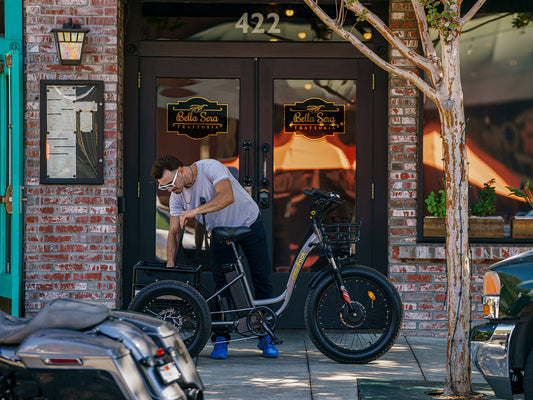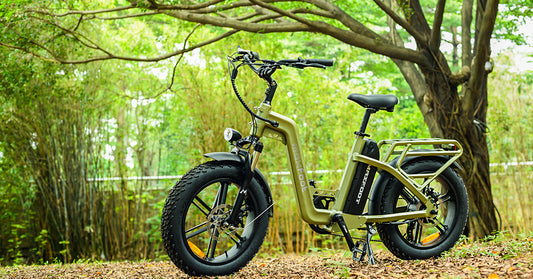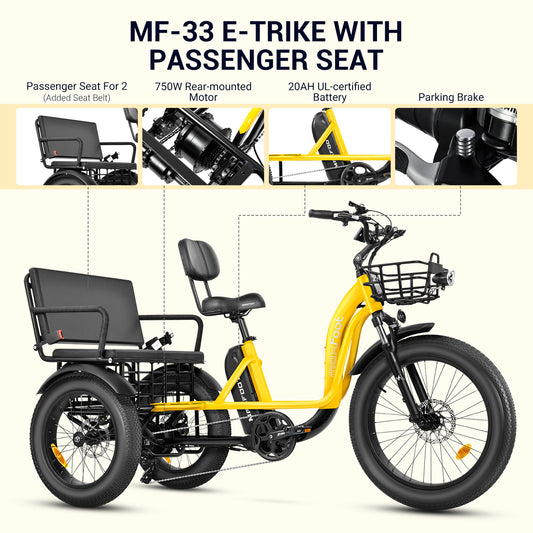E-bikes are rapidly gaining traction as an appealing substitute for traditional bicycles, piquing the curiosity of prospective buyers about their top speed.
Although e-bikes, like their conventional counterparts, can match your pedaling velocity, the intrigue often revolves around the maximum speed achievable through motor assistance and the limits sanctioned by US regulations. To put it succinctly, e-bikes in the US can attain a maximum speed of up to 28 mph, a standard endorsed by most states.
Further, in this article, we will intricately dissect the specifics of e-bike speed regulations within the US, placing particular emphasis on the speed capabilities of Maxfoot e-bikes.
E-Bike Classifications and Speed Limitations in the U.S
To understand the specific speed limits, you need to get aware of how US states have classified e-bikes. Mostly, they have divided them into three classes.
- Class 1: Pedal Assist e-bikes have a motor that only operates when the rider is pedaling. They can assist up to 20 miles per hour (mph).
- Class 2: Throttle on Demand e-bikes have a motor that can be activated by a throttle. Unlike class 1 bikes, you can propel the bike without pedaling. However, the speed limit is still the same, 20 mph.
- Class 3: Speed Pedelec e-bikes have a motor that can assist the rider up to 28 mph. However, the motor only activates when the rider is pedaling.
These classifications dictate the maximum assisted speed of the e-bike. It's worth noting that additional regulations might be imposed at the state level, so e-bike riders should be aware of the specific laws in their states.
In US states, electric bikes are subjected to all laws imposed on human-powered bicycles. Like them, you don’t require registration, licensing, or insurance for the vehicle. The rules state that Class 3 e-bikes can only be ridden by riders above the age of 16. And they need to wear a helmet while driving.
What factors influence the Speed of an Electric Bike?
The above-mentioned speeds are legally mandated maximums. In the actual case, the top speed of your bike depends on multiple factors such as motor power, battery, weight/load, road, and tire conditions.
- Motor Power:The power of the e-bike's motor plays a significant role in determining its speed. A powerful motor will generally be able to provide more speed, especially when it comes to overcoming resistance like hills or wind. For instance, a 1000W motor is capable of producing more torque and hence more speed compared to a 750W or 500W motor.
- Battery Capacity:Battery capacity can also influence speed. A battery that's near its limit won't be able to provide the same level of power as a fully charged one. Thus, maintaining a well-charged battery can help ensure maximum speed.
- Rider Weight:The weight of the rider can impact the speed of an e-bike. Heavier riders may find that their e-bike doesn't reach the same top speeds as lighter riders might experience, as the motor has to work harder to propel the extra weight.
- Terrain:The type of riding surface also affects your e-bike's speed since the motor has to overcome road resistance. Smooth, flat surfaces allow for higher speeds, while rough or uphill terrain can slow the bike down.
- Tire Pressure:Properly inflated tires can reduce rolling resistance, allowing the e-bike to travel faster. Conversely, under-inflated tires can create more resistance and slow the bike down. This makes it harder for the motor to maintain higher speeds.
An Overview of Maxfoot E-Bikes and Their Maximum Speeds
One brand that stands out in the e-bike market is Maxfoot. Known for its range of e-bikes, Maxfoot caters to a broad spectrum of cyclists with varying performance requirements. Our e-bikes typically lie under the second-class.
Here’s just a brief overview of Maxfoot bikes and their top speeds.
The Maxfoot MF-19 is a foldable, Class 2 e-bike, featuring a 500W or 1000W motor. The throttle enables the bike to reach speeds of up to 23 mph with motor assistance, making it a great option for daily commuting or leisure rides without requiring substantial physical effort.
For those seeking higher speeds and stability, the Maxfoot MF-30, a three-wheel electric trike bike, is an enticing option. With a robust 750W motor, it offers a top-assisted speed of 20 mph when the rider is pedaling. This makes it suitable for longer rides and small delivery businesses where you need some extra space.
We also have two cruiser bikes for cycling enthusiasts, Maxfoot MF-17 and MF-18, both feature a powerful 750 W and a slightly different strep-thru design. Their strong motor allows you to propel up to 23 mph.
Final Words
While e-bikes offer a quicker, more efficient alternative to traditional bicycles, their speed is regulated in the U.S. to ensure the safety of all road users. Maxfoot e-bikes, designed to comply with these regulations, provide riders with an enjoyable, speedy, yet safe cycling experience.
Although we have mentioned the generally allowed speed limits, always go through local state regulations and personal riding conditions before settling on a specific e-bike model or speed. Safety, above all else, should be the driving factor behind any e-bike speed considerations.




